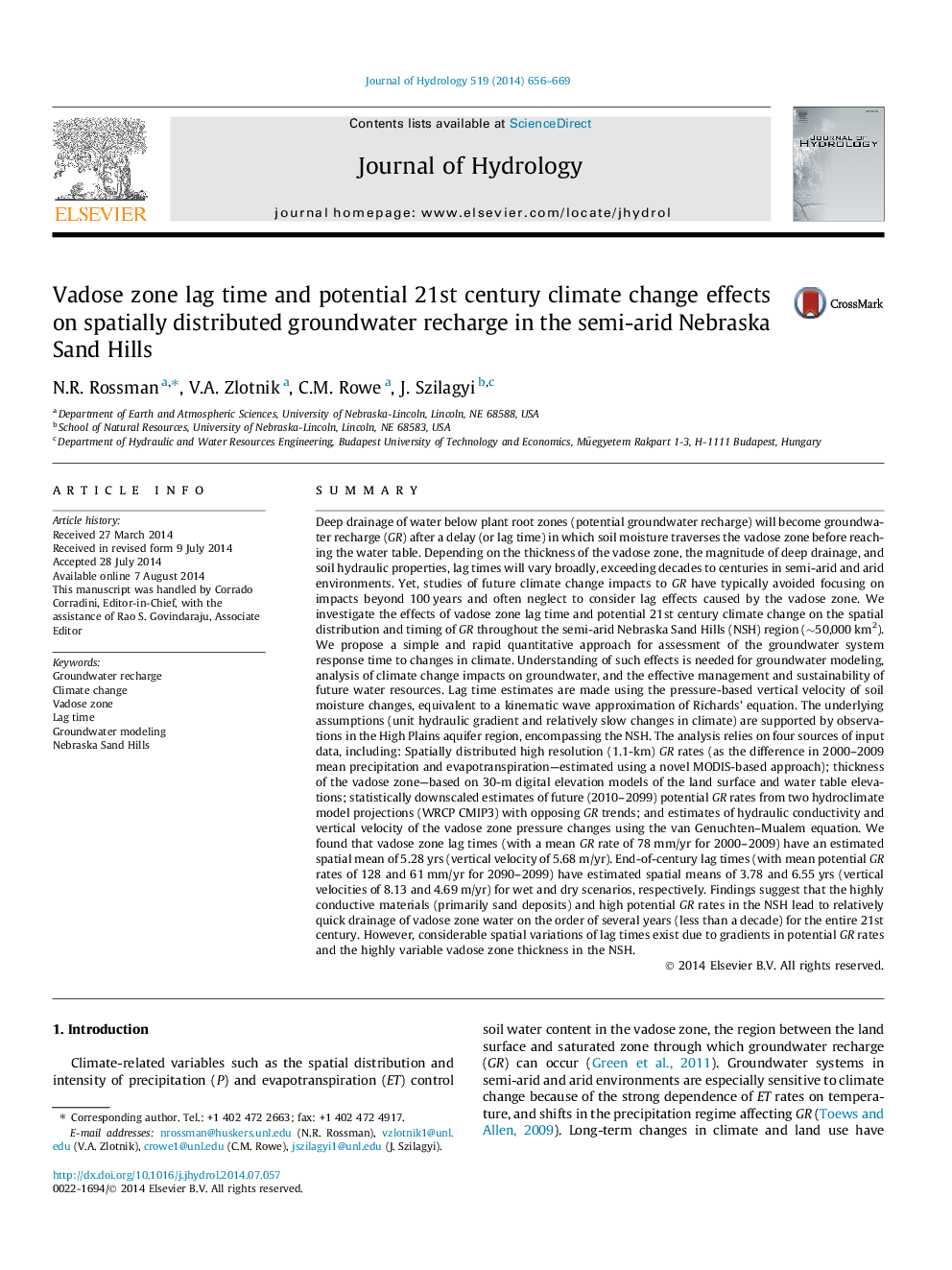| کد مقاله | کد نشریه | سال انتشار | مقاله انگلیسی | نسخه تمام متن |
|---|---|---|---|---|
| 6412463 | 1332898 | 2014 | 14 صفحه PDF | دانلود رایگان |

- A simple analytical approach is proposed to estimate vadose zone moisture lag time.
- Lag times vary greatly depending on vadose zone thickness and climate conditions.
- Average lag time estimates are no longer than a decade for the Nebraska Sand Hills.
- More than 75% of the groundwater system is affected within 10Â yrs for all conditions.
- Uncertainty due to hydraulic parameters is larger than that due to climate scenarios.
SummaryDeep drainage of water below plant root zones (potential groundwater recharge) will become groundwater recharge (GR) after a delay (or lag time) in which soil moisture traverses the vadose zone before reaching the water table. Depending on the thickness of the vadose zone, the magnitude of deep drainage, and soil hydraulic properties, lag times will vary broadly, exceeding decades to centuries in semi-arid and arid environments. Yet, studies of future climate change impacts to GR have typically avoided focusing on impacts beyond 100Â years and often neglect to consider lag effects caused by the vadose zone. We investigate the effects of vadose zone lag time and potential 21st century climate change on the spatial distribution and timing of GR throughout the semi-arid Nebraska Sand Hills (NSH) region (â¼50,000Â km2). We propose a simple and rapid quantitative approach for assessment of the groundwater system response time to changes in climate. Understanding of such effects is needed for groundwater modeling, analysis of climate change impacts on groundwater, and the effective management and sustainability of future water resources. Lag time estimates are made using the pressure-based vertical velocity of soil moisture changes, equivalent to a kinematic wave approximation of Richards' equation. The underlying assumptions (unit hydraulic gradient and relatively slow changes in climate) are supported by observations in the High Plains aquifer region, encompassing the NSH. The analysis relies on four sources of input data, including: Spatially distributed high resolution (1.1-km) GR rates (as the difference in 2000-2009 mean precipitation and evapotranspiration-estimated using a novel MODIS-based approach); thickness of the vadose zone-based on 30-m digital elevation models of the land surface and water table elevations; statistically downscaled estimates of future (2010-2099) potential GR rates from two hydroclimate model projections (WRCP CMIP3) with opposing GR trends; and estimates of hydraulic conductivity and vertical velocity of the vadose zone pressure changes using the van Genuchten-Mualem equation. We found that vadose zone lag times (with a mean GR rate of 78Â mm/yr for 2000-2009) have an estimated spatial mean of 5.28Â yrs (vertical velocity of 5.68Â m/yr). End-of-century lag times (with mean potential GR rates of 128 and 61Â mm/yr for 2090-2099) have estimated spatial means of 3.78 and 6.55Â yrs (vertical velocities of 8.13 and 4.69Â m/yr) for wet and dry scenarios, respectively. Findings suggest that the highly conductive materials (primarily sand deposits) and high potential GR rates in the NSH lead to relatively quick drainage of vadose zone water on the order of several years (less than a decade) for the entire 21st century. However, considerable spatial variations of lag times exist due to gradients in potential GR rates and the highly variable vadose zone thickness in the NSH.
Journal: Journal of Hydrology - Volume 519, Part A, 27 November 2014, Pages 656-669